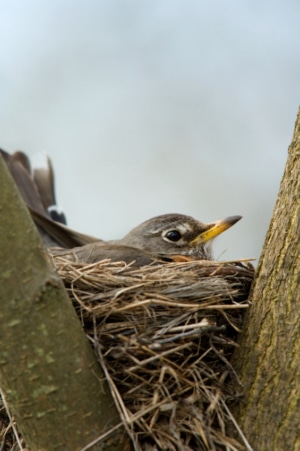Originally written November 12, 2007
by Christopher K Travis
(Copyright 2007- All Rights reserved)
“Home” is a powerful metaphor. Like other concepts that are central to the human condition, it has a broad range of meanings. It is used to refer to both artifacts and experiences. The sense of intimate place, the claiming of territory, the encounter with “belonging” to the physical world around us that we refer to as “home,” is an ancient and central experience within all cultures.

The “experience of home” predates language and humanity itself. We may be the first species to think about our homes in a conceptual way, but we are the not the first to make them central in our lives. The need to claim a personal space is innate in the behavior of a wide range of living organisms. All through the natural world, the call to home is experienced and expressed in thousands of different ways.
A home is a safe haven that a living organism maintains in order to accomplish a greater degree of predictability and control in its life. A bee has a hive. A bear has a den. You have your house. Bacteria have your large intestine.
All types of habitations – from tents to high rises to your gut – serve as homes.
Most of us think of the house or structure we inhabit as “home.” For others, it is the place they were reared. We come from “home towns” and return to visit our “home folks” where we are served “home cooking.” Our friends are our “home boys” and our ancestry is defined by our “homeland.” In the last fifty years, we have begun to understand that the earth is our “home planet” and that we must be responsible for it.
Home has more to do with a declaration of space than the space itself, and therefore the concept of “home” includes the places we and other animals claim by our behavior. A rutting bull will lay claim to its pasture. A troupe of baboons will protect its foraging territory. My wife always gets to choose which side of the bed is hers.

A home serves to protect its inhabitants from the uncertainties of the world…but is that all it does?
A cell membrane, by this criteria, defines the “home” in which a cell exists. Inside that protective shield the vulnerable contents of the cell are contained and protected. Is a cell membrane the “home” of the nucleus and protoplasm, or merely a body part?
Our bodies might also be considered a “home” by this definition, protected as they are by a layer of skin that separates us from the rest of the world. We say a person who is not at peace with themselves, someone experiencing anxiety or apprehension, is “…not at home in their own skin.”
Viewed deeper, the home is not a physical place at all, but an experience that lives within the heart. We describe the experience of feeling relaxed and letting down our guard as “feeling at home.” That sense of belonging is much sought after but often remains elusive. When we say “a house does not make a home,” we are making reference to this fact.
Home can also imply other types of internal experience. Our comments can “hit home.” We can “be at home” on any subject. Our loved ones can have a “home in our hearts.” Thus our definitions of “home” can range from the most private experiences of the individual outward to include our family, our community, our world view and our ideologies.

According to one of my science heroes, physiologist J. Scott Turner, there are countless organisms who build homes that function essentially as “organs of external physiology.” In his book, The Extended Organism, he notes many species who literally cannot survive without the adaptive mechanism of a “home.”
But what about animals like ourselves who cannot extrude our homes from our bodies? Are our homes a manifestation of our selves? Do our homes simply define where and how we live, or do they demonstrate who we are? Are they expressions of our culture and our communities – or simply a practical response to the need for shelter?
In House as a Mirror of Self, architect Clare Cooper Marcus points out that “…throughout our lives, whether we are conscious of it or not, our home and its contents are very potent statements about who we are.”
In the Poetics of Space, Gaston Bachelard calls the home “…the human being’s first world” and suggests that “Before he is ‘cast out into the world,’ man is laid in the cradle of the house.”
In Some Place Like Home, environmental psychologist Toby Israel writes, “All human beings – everyone, everywhere and always – begin existence in homes constructed of the same material, of the same shape, size, light, sound, and temperature. We all begin life in the womb.”

But in order to understand the nature and origins of how humans relate to their homes, we must begin our investigation with a definition that describes the complex experience in its most basic form…one shared by a broad diversity of living things.
Obviously, a home is a specific locale in the physical world that has been claimed as a personal space by its inhabitant – but it is not simply the space itself or the material structure that surrounds the space – nor is it simply the claim of territory or the “sense of belonging.” Nor is it merely the perception or “state of being” experienced by the resident. For any animal, a home is all of those and more.
Thus I hazard my own definition.
“Home” is the complex relationship between the physical characteristics of claimed intimate space – the experience, nature and behavior of the inhabitants of that space – and the environment in which all occur.
Like a forest, a pond, a city or a living body…a home is a living eco-system. It is a complex suite of relationships that grows and adapts to the world around it.
The actors in the system are not only the people who live in or visit that space – like yourself, your family, your friends and the other human beings who you invite into your home – but also your dog and the insects, rodents and micro-organisms who share your “home” with you.
Together all dance with the physical space all share in common.
